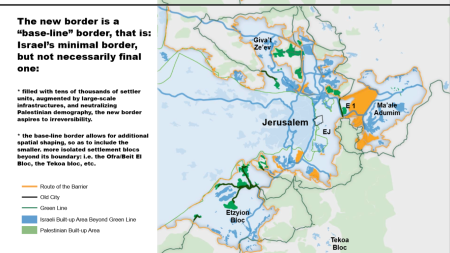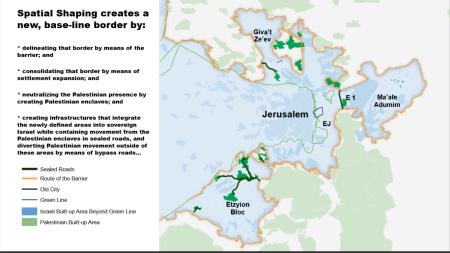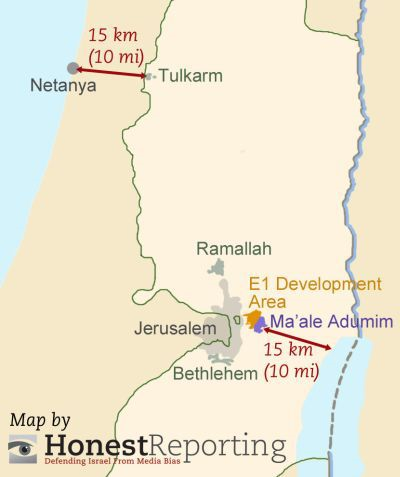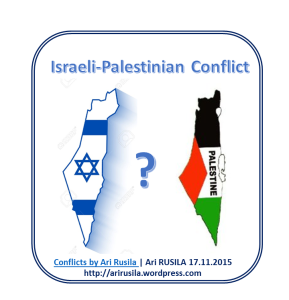“There’s no such thing as proper timing, and I expect the prime minister and the ministers to approve the bill come Sunday.” (Ma’aleh Adumim Mayor Benny Kashriel)
 Jerusalem is the core of the Israeli-Palestinian conflict. Competing religious, national, and historic narratives – Israeli, Palestinian, Jewish, Muslim, and Christian – exist side-by-side in the city, in a constant struggle for legitimacy, validity, and survival. Now the bill annexing Ma’ale Adumim, an Israeli city in Judea, some four miles from Jerusalem, is likely to be brought to a vote at the Israeli Ministerial Legislative Committee on 5th Mar. 2017.
Jerusalem is the core of the Israeli-Palestinian conflict. Competing religious, national, and historic narratives – Israeli, Palestinian, Jewish, Muslim, and Christian – exist side-by-side in the city, in a constant struggle for legitimacy, validity, and survival. Now the bill annexing Ma’ale Adumim, an Israeli city in Judea, some four miles from Jerusalem, is likely to be brought to a vote at the Israeli Ministerial Legislative Committee on 5th Mar. 2017.
The bill will make the ongoing de facto annexation of the surrounding communities of greater Jerusalem on de jure annexation.
The bill
According JewishPress the bill’s sponsor, MK Yoav Kisch (Likud), wanted to submit it to the committee for a vote several weeks ago, but Prime Minister Netanyahu torpedoed the move, citing the need to avoid upsetting President Trump by acting unilaterally on issues that are entirely outside the purview of US foreign policy. Now that Trump has declared his official disinterest in how a resolution of the conflict between Israel and the Palestinian Authority would be reached, the time has come to bring it to a preliminary Knesset vote before Passover.
The bill imposes Israeli law on the city of Ma’ale Adumim, which for close to three decades has been under martial law, like all the other Israeli towns and villages in Judea and Samaria. Basically it is a question of freeing the Israeli communities in Judea and Samaria from Army.
The threat against a future Palestinian State is based on the fact that the four-mile stretch of land dubbed E1 by the Oslo accords, between Ma’ale Adumim and Jerusalem, would eventually come under Israeli law, too, following the annexation of the young city. (Source and more: JewishPress).
The effort to formally define “Greater Jerusalem” is not a new issue. Earlier – on February 2017 – Likud MK Yehuda Glick introduced legislation entitled the “Greater Jerusalem Sovereignty Law” to formally annex these areas as part of Jerusalem; not long before that, Likud Minister Yisrael Katz introduced legislation to annex much or all of the same area, entitled the “Greater Jerusalem Law that includes extending Israeli sovereignty to the surrounding communities of greater Jerusalem: Ma’ale Adumim, Givat Ze’ev, Beitar Illit and the Etzion Bloc.
The end of Two-State?
Israel’s plans has rise concern in some European capitals. It was claimed that annexations like E1 area by joining with Maa’ale Adumim community – a city of some 40,000 residents – would cut the West Bank in two and separate it from East Jerusalem which would make any two-state solution impossible. This claim does not hold as bypass roads are the answer.

A completed section of the Palestinian bypass road. Its final completion will enable transportation continuity between the northern and southern West Bank, similar to other existing “fabric of life” roads built for the Palestinians. Credit: JCPA
In addition to improve better traffic flow between the northern and southern WB Israel has already made some investments. In October 2007, the Israeli government expropriated 1,100 dunams of land from four Palestinian villages to build an access road that was given the moniker “the Palestinian quality of life road.” The road was designed to provide for a freer flow of Palestinian traffic between the Ramallah area and Bethlehem. The northern sector of the highway, which runs from Hizma and bypasses Anata from the east, and continues southward toward the A-Zaim checkpoint, has already been paved. Israel invested about NIS 300 million in building the highway. The roadway passes through a tunnel that was dug underneath the Jerusalem-Maa’ale Adumim highway. Moreover, Israel proposes to build tunnels or overpasses to obviate the need for Palestinians to detour to the east through the corridor.
Spatial shaping
According Terrestrial Jerusalem (an Israeli non-governmental organization) a policy of allowing Israeli construction in the settlement blocs around Jerusalem grants legitimacy to the establishment of a massive “Greater Jerusalem” under permanent Israeli sovereignty. This, in turn, implies acquiescence to the view that East Jerusalem – both its settlements and its Palestinian neighbourhoods – will be permanently under Israeli control.
Continued settlement expansion within the settlement “blocs” – even at current levels – would not only unilaterally pre-determine borders in areas very much in dispute (consist with Israel’s longtime policy of “spatial shaping” on the ground), it would pose a real and present danger to the very possibility of the two-state solution. Rather than promoting peace or even keeping the two-state solution on “life-support,” adopting a policy of allowing settlement.

Spatial shaping is being achieved by four, complementary components:
- Delineating the base-line border, by means of the route of the barrier
- Consolidating the newly defined border by means of settlements
- Neutralizing the Palestinian presence within the new borders
- Creating infrastructures that integrate the new “Israeli” areas into pre-1967 Israel, and functionally detach the Palestinian population in these areas

Source and more: Limiting Settlement Construction to the “Blocs” – Implications for Jerusalem, by Terrestrial Jerusalem
My view
I disagree with those views which claim that Israeli Great Jerusalem will be the terminal point of Two-State solution. As a a map – created by HonestReporting – shows the Palestinian waistline — between Ma’ale Adumim and the Dead Sea, is roughly 15 km wide. That’s a corridor no different than the Israeli waistline according pre 1967 boundaries. That’s a corridor no different than the Israeli waistline. Indeed, that has never caused a problem of Israeli territorial contiguity.

Great Jerusalem plans and e.g. moving US embassy there put the finishing touches to Jerusalem as the capital city of Israel; same time they probably will block fancies of Jerusalem as capital of future Palestinian state. However Palestinian administrative HQ’s mainly are already in Ramallah – next of Jerusalem northern boundary.
I agree with the critical conclusions that a policy of allowing Israeli construction around Jerusalem will unilaterally pre-determine borders as well those components which are implementing sc spatial shaping on the ground; however I support this now ongoing policy. From my point of view de jure annexation transfers the area from Army control under Israeli Law and this change creates more stable and legitimizes the long term development than continuity of the status quo.
Related articles:
Forgotten Court Rule: Israel Is The Legal Occupant Of Judea And Samaria
Will (East) Jerusalem be the End of Two-State Illusion?
UNESCO: The Temple Mount Is Sacred Only To Muslims
Analysis: Resolving The Israeli-Palestinian Conflict
Will Obama Reset The Middle East Peace Process?


